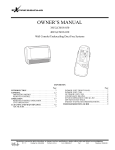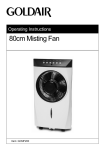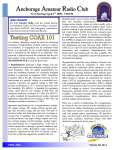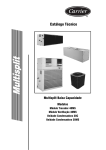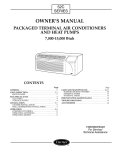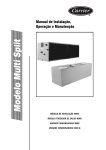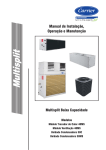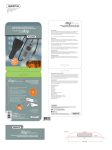Download Carrier G Series Cooling Specifications
Transcript
42XQ 42XQA 42XQ : Cooling only direct expansion Fan Coil Unit (Wireless Control) 42XQA : Cooling only direct expansion Fan Coil Unit (Wired Control) Thank you for choosing Carrier! You can be sure that you’ve made a wise choice, because the same pride we take in manufacturing the Carrier equipment installed in the Astrodome in Texas, in the Sistine Chapel, in the Capitol – the seat of the US Congress – and in thousands of other installations worldwide, is embodied in the design of the unit you have just purchased. One of the greatest benefits to await you when using your air conditioner is that, in addition to maintaining a pleasant temperature in the area where it is installed, the ambient air is also filtered and dehumidified, thus improving the quality of the air you breathe. This manual has been created to familiarize you with all of the technological features and benefits which this air conditioner unit can offer. This manual also contains important information regarding the maintenance of your new air conditioner, servicing the unit and, above all, running it in an economical way. Set aside a few minutes to carefully read through the contents of this manual and learn to optimize the use of your new Carrier device in terms of personal comfort and economy of operation. CONTENTS PRECAUTIONS 3 Safety considerations 3 DISPLAYS OF THE INDOOR UNIT, LED INDICATORS & CONTROLS 6 Error codes 6 Emergency operation 7 REMOTE CONTROL 8 Using the selected functions 10 Using the wireless remote control 11 Using the wired remote control 17 Setting the operating mode 19 INFORMATION ABOUT FILTERS 21 CARE AND MAINTENANCE 22 Operating conditions 22 Operation during power outages 22 PRACTICAL TIPS 23 Cleaning the Indoor Unit 24 Cleaning the Outdoor Unit 24 Cleaning the filters 25 PRECAUTIONS Safety considerations The installation, servicing and maintenance of air conditioning equipment may be hazardous due to the pressure which the refrigerant gas exerts on the interior, and its electrical components. Only specialized and professionally qualified personnel may install, repair or perform servicing work on air conditioning equipment. Non-specialized people may only perform basic maintenance work such as: cleaning the coils and cleaning and/or replacing the filters. All other types of maintenance work may only be performed by specialized personnel. To perform such work, the installer must follow the safety standards applicable, and must wear safety goggles, clothing and gloves suitable for this purpose. Appropriate protection must be used during welding work; a fire extinguisher must always be kept close to hand. For your safety, read these instructions through carefully and respect all of the labels marked WARNING below. WARNING Recognize the safety information The symbol “ ”! indicates a safety alert. When you see this symbol, it is because there is a potential risk of material damage or personal injury. Understand the meaning of the words DANGER, WARNING AND CAUTION. These words are used in conjunction with the alert symbol. DANGER means situations with a severe risk to injury to people, including the risk of death. The word WARNING means situations which could result in personal injury, including death. The word CAUTION indicates unsafe practices which could result in minor personal injury or material damage. ! • Do not attempt to interconnect units from different manufacturers without first consulting your Carrier representative or an engineer specializing in air conditioning. The incompatibility between the indoor and outdoor unit and its control devices could cause serious problems for both units and invalidate the manufacturers’ warranty coverage. Carrier accepts no liability and will cancel the product warranty if these installation instructions are not followed as indicated, or if the wiring is changed. Consult your preferred Carrier representative for further details. 3 WARNING or CAUTION contained in this manual or attached to the housing of the unit. Consult your local regulations applicable with respect to electrical installations for special requirements. • Before installing, modifying or performing servicing work on the system, check that the electrical power supply to the unit has been switched off. Check that there is not more than one power switch. Check and label each switch present with the appropriate wording. Electric shocks can cause personal injury, and even death. If the power supply cable is damaged, it must be replaced only with an authorized Carrier spare part by its network of authorized dealers. CAUTION ! DISCONNECTING THE UNIT FROM THE MAIN POWER SUPPLY These units must be connected to the main electrical power supply through a circuit-breaker or switch fuse with an appropriate capacity and with a minimum separation between the contacts of 3mm. If this is not possible, a contact/container combination equipped with an active earth wire must be used. The contact must have easy access after installation. The contact must be disconnected from the receptacle to ensure that no electrical power gets to the unit. It is vitally important to follow the safety standards in force at the connection location and also to check that the electrical power supply is actively equipped with an earth cable WARNING Do not spray flammable aerosols near to the unit. The unit may be damaged if it comes into contact with gasoline, solvents, benzene, insecticides or other chemical substances. To prevent electric shocks, never splash water into either the indoor or outdoor units. ! Do not attempt to disconnect the unit at the main power switch. Always use the unit’s control when you want to disconnect the system. Do not insert your hands or fingers, or place objects inside the air discharge grille of the outdoor unit, because the fan rotates at very high speeds, which may cause serious personal injury. 4 Use only a circuit-breaker with a suitable capacity. Keep the unit away from heat sources. High temperatures may cause physical damage to the unit. Do not obstruct the air discharge of any of the indoor and outdoor unit. Doing so, blocks the airflow, reducing the cooling capacity and causing the unit to malfunction. In summer, prevent sunlight from entering the air-conditioned area as far as possible. You can do this by using curtains or blinds on the windows. The manufacturer accepts no liability in the event of damage caused by: mistakes or changes when establishing the electrical connections or refrigerant gas connections, during installation or due to the inappropriate use of the equipment. Failure to observe these instructions will immediately invalidate the warranty of your unit. Use the voltage indicated on the unit’s data plate. Using a voltage different from the specified voltage may cause very serious damage to the unit. This unit will only operate correctly if it is installed and tested by personnel professionally qualified and trained for such work. 5 DISPLAYS OF THE INDOOR UNIT, LED INDICATORS AND CONTROLS T : EMERGENCY and RESET button S : Receiver of remote control signal P : Green LED R : Yellow LED Q : Red LED NOTE Indoor Unit LEDs Information about the operating mode of the indoor unit is given by the 3 LEDs (lightemitting diodes) on the unit. 0 THE GREEN LEAD (P) indicates the followings: • Error diagnosis • During normal operation, the LED is illuminated. ERROR CODE • When the unit is disconnected or in Standby mode (waiting), the LED remains switched off. If a breakdown occurs, the LED flashes at 5-second intervals. The error code is shown by the number of times the LED flashes. A pause of 5 seconds occurs between the luminous signal cycles. DESCRIPTION 3 Ambient temperature sensor error 4 Indoor unit coil sensor error 7 Outdoor unit error 10 EEPROM malfunction 11 Corrupted serial number 12 Incomplete address/zone information 13 Gas flow distribution error 6 0 THE RED LED (Q) indicates the following information • During normal operation, the LED is switched off. • During defrosting, the LED is illuminated. • During the testing of the electrical connections, the LED flashes at 1 second intervals. 0 THE YELLOW LED (R) indicates that the unit is operating in timer mode. During this operating mode, the LED is illuminated. If timer mode is active and the unit is reset immediately after a stop, this LED flashes after receiving a new signal from the unit. NOTE • Positioning of the selector key: the units leave the factory configured for the underceiling position. CONSOLE : Position 1 UNDERCEILING : Position 0 If in doubt, refer the Installation and Operation Manual. “EMERGENCY button” (T) This may be used when the remote control is not working or has been lost. Emergency Operation When the unit is in OFF mode (disconnected) and you press the emergency button for 5 seconds, the unit starts operating as follows: • • • • Automatic mode Temperature at 22°C Automatic fan speed The air deflectors are positioned automatically according to the operating mode – see note • Timer deactivated during cleaning or replacement of filter 7 NOTE According to the signal received via the remote control, the unit starts operating according to the command selected. “RESET” (T) This button must be pressed for one second to revert to normal operation of the unit after cleaning work or replacing the filter. REMOTE CONTROL The remote control works with 1.5 V batteries. When the battery icon appears on the display of the remote control, it’s time to replace the old batteries. CAUTION ! Before replacing the batteries, the device must be disconnected. Inserting the batteries • Open the battery compartment on the back of the remote control. To remove the small cover, press down the small tab in the direction indicated by the arrow in the diagram. • Remove the old batteries and insert new ones. The remote control requires two batteries (1.5V type AAA). • Press the “o” button with a sharp-pointed object to reset the remote control. NOTE • The average life of the batteries under normal conditions of use is approximately one year. • If the air conditioner does not function as normal after the remote control batteries have been replaced, remove the batteries again, reinsert them and press the “o” button again after 5 seconds 8 NOTE • The maximum distance for the infrared remote control to work properly is 5 metres. • There must be no objects, for example, curtains, obstructing the space between the unit and the remote control. NOTE • Sunlight shinning directly onto the signal reception area of the unit may cause difficulties in receiving the signal emitted by the remote control. • The remote control must be pointed towards the device’s signal reception area when you press the desired button. • The electronic control system emits an acoustic signal (beep) to confirm the reception of the emitted message. Reading on the display or viewfinder A. Operating mode selection button B. ON/OFF button – Connect/disconnect C. Button for increasing the selected temperature D. Button for reducing the selected temperature E. Fan speed selection button F. Customized control button G. Customized selections button H. Deflector control button I. Button for connecting the timer (ON) J. Button for the daily timer (DAILY) K. Button for canceling the timer setting L. Button for disconnecting the time (OFF) M. Button for setting the night operating mode (SLEEP) N. Button for setting the time O. Reset button 9 USING THE SELECTED FUNCTIONS 6. Configuration of the unit • Ventilation (fan only) 7. Low battery indicator • Cooling with dehumidification 8. Position of the air deflector • Dehumidification only 9. Fan speed 1. Operating mode (from left to right): 10. Active customization 2. Signal transmission symbol 11. Timer ON selected 3. Temperature reading 12. Night timer activated 4. “Address” selector 13. Day timer activated 5. Temperature measuring unit (°C or °F) 14. Timer ON, OFF and clock 15. Timer OFF selected 10 USING THE WIRELESS REMOTE CONTROL Connect / Disconnect (Key B) Indicated symbol Ventilation (fan only) When the air conditioner is disconnected, the control display shows only the hour of the day (if other icons are shown, disconnect the control by pressing the “ ”button). Press the “ ”button to connect the unit. All of the selected and saved functions light up; the unit operates according to the functions selected. Press the “ ”button to disconnect the air conditioner. All of the unit’s signals disappear and the control display shows the current time only. If the unit does not stop, connect the control (by pressing the “ ”button) and repeat the operation. If the “ ”button is pressed immediately after the disconnection of the unit, the unit only starts operating again after 3 to 5 minutes due to the protection against the frequency cycle of the compressor. The unit only emits the BEEP acoustic signal when the orders have been received correctly. Select the Operating Mode (Key A) Cooling with dehumidification Dehumidification only Setting the desired temperature Increase (Key C) Decrease (Key D) By pressing the buttons “ ” and “ ”, you increase or decrease the desired ambient temperature. With each touch of the button, the unit emits the confirmatory BEEP acoustic signal and the selected temperature appears on the display. The selected temperature may be between 17°C (63°F) and 32°C (90°F) at 1-degree intervals. NOTE The operating mode of the air conditioner can be selected with this button. By pressing this button repeatedly, the available operating modes are selected sequentially. The unit recognizes the signal received with a confirmation BEEP and the operating mode selected is indicated as follows: 11 In cooling mode, if the temperature selected is higher than the ambient temperature, the unit will not start operating. Selecting the airflow direction (Key H) Selecting the fan speed (Key E) The deflector direction must be set so as to optimize the ambient airflow distribution. The fan speed can be selected by pressing the button with the icon Press the button until one of the following positions is displayed: Indicated symbol Icons appearing on the display The airflow direction is adjusted automatically. The deflector will remain in the pre-selected position, according to the operating mode. 6 different airflow directions may be selected. The deflector will continue to swing downwards and upwards. The “Swing” option guarantees an effective and uniform distribution of ambient air at all times. Low speed (for night operation) Medium speed High speed (from when the unit is turned on until the desired temperature is reached) Automatic (the fan speed changes automatically to the value providing the best possible comfort) Programming the Timer to start (ON) Cooling with dehumidification NOTE In COOLING, DE-HUMIDIFICATION and VENTILATION modes, the deflector swings to the COOLING option. 1. Timer ON button (Button I) Press this button even if the remote control is turned off. The relevant icon and the picture of the clock start flashing. If you do not press a button for 10 seconds, the remote control switches itself off (it was already switched off when the button was pressed), or the timer function is automatically deactivated. 12 2. HOUR and MINUTES buttons ( ∧ and ∨ buttons) If the unit is connected, the only possible selection is the time of starting operation. The unit operates with the selections shown on the display. 3. HOUR and MINUTES buttons ( ∧ and ∨ buttons) If the unit is disconnected: select the operating start hour and use the temperature control buttons ( ∧ and ∨ buttons). First select the hour and then confirm by pressing the button . Then select the minutes using the buttons ∧ and ∨ . To set the clock permanently, press button again. 4. Operating mode Select the operating mode of the unit. The icons begin to flash. To select the mode, use the M button. After selecting the mode, press the button. The icon of the selected mode starts flashing. 5. Desired temperature To select the desired temperature (the value will be flashing), use the ∧ or ∨ buttons. Press button to confirm the selection. The numbers stop flashing. 6. Fan speed Select the fan speed using the button. After making your selection, press button to confirm. The icon stops flashing. 13 7. Positioning the air deflector This icon now flashes. Use button select the desired position. to Press button to confirm. Now all of the icons are fixed on the display. If you want to cancel the selections made up to now, press button X; if you want to cancel the selections since the timer was set, press button and then button X Programming the Time to stop (OFF) 1. TIMER OFF button (Button L) Press button . The timer OFF icon and the hour selection numbers start flashing. This function may be selected even with the remote control disconnected. 2. HOUR and MINUTES selection buttons ( ∧ and ∨ buttons) To select the clock, press the ∧ and ∨ . To toggle between hours and minutes, press button . Press button again to confirm. Customization (Button G and F) and If you want to save a customized operating mode which you can reactive at any time, complete the following steps: 1. With the remote control connected or disconnected, press button and keep it pressed down for more than 5 seconds. The customization icon starts flashing on the display. Daily timer (DAILY - button J) Press button when timer ON or OFF is active. The icon appears on the display. In this way, the saving of the timer ON and OFF is repeated daily. To deactivate the daily function, press button again. Combining the TIMER ON, OFF and DAILY programming 2. Press button M to select the operating mode. If you want the unit to start operating at 5:30pm and stop operating at 10:30pm, proceed as follows: 3. Press button ∧ and ∨ to select the desired temperature. 1. Select timer ON for 5:30pm 4. Use button 5. Use button position. to select the fan speed. to select the deflectors’ 2. Select timer OFF for 10:30pm 3. Select the desired operating mode (button M ) 6. After entering all the selected options, press button to save them. NOTE After this procedure, all of the selected and saved functions will be able to be activated using button , regardless of the operating mode of the unit. If you want to stop the unit at 10:30pm and restart at 7:30am with the same operating mode, proceed as follows: 1. Select timer OFF for 10:30pm during operation 2. Select timer ON for 7:30am. After entering customized mode, press one of , ∧ , ∨ or to exit. If you the buttons: M, want to change one or more saved settings, return to point 1 and restart the setting procedure. 14 If you want the daily operating mode to start at 530pm and stop at 10:30pm, proceed as follows: Programming the night timer (SLEEP - button M) 1. Select timer ON for 5:30pm 2. Select timer OFF for 10:30pm 3. Press the button of the daily operating mode (Button ) Press this button to set the night timer (SLEEP) with the remote control connected. The icon appears on the display. This procedure allows you to set the remaining operating time of the unit. 1. “1:hr” appears on the display, together with the icon. 2. Press button ∧. The display shows the following selections in the sequence: Canceling the ON, OFF and DAILY TIMER programming 1 hr, 2 hr, 3 hr, 4 hr, 5 hr, 6 hr, 7 hr, 8 hr and 9 hr 3. Once you have selected - using the buttons ∧ or ∨ - the remaining operating hours, press button again to confirm. 1. If you want to cancel the selection of ON or OFF timer, press the buttons, following this sequence: 4. After the night timer has been set, the unit will check the selected temperature to prevent excessive cooling during operation. • Button or • Button X To deactivate the daily function, press button operating mode NOTE The daily operation function will remain active until one of the two timers (ON or OFF) is activated. 15 Buttons for setting the time resetting (Button N and O) and Press the clock setting button to adjust the real time. Press the button “o” with a sharppointed object, if the remote control is not working properly or after replacing the batteries. CAUTION !!! Setting the hour (Button N) 1. With the remote control connected or disconnected, press button . The air conditioner will not work if there are curtains, doors or other objects blocking the signal sent from the remote control to the unit. 2. The numbers of the hour start flashing. Press button ∧ or ∨ to set the desired hour. Press button to switch to the minutes, in order to set them. 3. To make this selection, always use buttons ∧ or ∨. If the infrared signal receiver of the indoor unit is directly exposed to the sun’s rays, the equipment will not function properly. Block the incidence of sunlight until the exposure has been eliminated. 4. After setting the hour, press button to confirm. NOTE Together with the remote control, you will receive a mounting support to put it inside. Attached the support the wall. “Address” Selector • If there are two indoor units in the same room, you can connect one remote control to one indoor unit and the other remote control to the other unit, or you can control both units using just one remote control. • For the configuration, consult the Installation & Start-up Instruction’s Manual. NOTE Always use the remote control to set the position of the air deflectors; otherwise operational anomalies may result. Disconnect the unit and reconnect it when manually setting the grid outside of the range. 16 Control to the left and right Specifications If you want to set the direction of the air to the right or left, adjust the deflector by hand after opening the horizontal deflector. • Operating Modes: Off (disconnected), Cool (refrigeration), Dry (dehumidification), and Fan only (ventilation) • Fan Speeds: Low, Medium, High and Auto • Deflector temperature: Between 17 and 32°C (63 and 90°F) NOTE DO NOT adjust the deflector by hand if the unit is operating in SWING mode, since this may damage the air oscillation mechanism. • Cancellation of temperature sensor of unit: Allows you to use the air sensor located on the remote control instead of the sensor located inside the unit. • Diagnostics: Detects errors in the remote control air sensor. 0 The code “A1” shown on the display indicates this anomaly. (up) WIRED REMOTE CONTROL General Information and Specifications (down) “UP” and “DOWN” buttons Buttons for increasing or decreasing the temperature or selecting the air deflector modes “AUTO” or “SWINIGING” Operating mode selection button. Air deflector or fan selection button. A = Reading on the display B = Increase temperature / change the air deflector setting button C = Decrease temperature / change the air deflector setting button D = Fan speed selection button E = Operating mode selection button 17 Display the selected functions Control Powered Up All of the segments of the Remote Control Display must be powered up for five seconds. Information about the operating mode, fan speed, desired temperature and configuration must be read from the Microprocessor inside the Remote Control. If the EEPROM values are not valid, the following must be used by default. 1. Disconnected 2. Selected temperature/ambient temperature 3. Set temperature Example of normal operation 4. Deflector operating position 5. Fan speed 6. Refrigeration 7. Dehumidification only When connected, the control display appears. Operating Mode = AUTO Fan Speed = AUTO Desired Temperature = 22°C °F or °C = C Deflector (louver) = AUTO Cancellation of the Ambient Thermistor = OFF Refrigeration Only = Cool 18 SETTING THE OPERATING MODE COOL and DRY modes • ICON of the Operating Mode. “MODE” button Pressing the “MODE” button causes the operating mode to change. The “MODE” button must be released and then pressed again to switch to the next mode. The active mode will always be displayed in normal operation. • Ambient Temperature: if configured by canceling the temperature sensor of the ambient environment unit (operated by the environment controller); otherwise the temperature is selected by the user with the “SET TEMP” icon. • FAN/LOUVRE icon with the Fan and Louver settings – air deflector – selected by the user. NOTE If the “MODE” button is not pressed for 15 seconds, the next command always changes the mode to OFF. The available operating modes to select from are: Available Buttons • All the Buttons are available. DRY Dehumidification Operation Remote Refrigeration Only OFF (disconnected) COOL Refrigeration Operation COOL (refrigeration) DRY (dehumidification) FAN ONLY (ventilation) OFF Mode • OFF mode • Ambient Temperature: if configured by canceling the ambient environment sensor. Otherwise none. Available Buttons • “MODE” button 19 FAN ONLY mode “FAN” button FAN ONLY Operation with fan ventilation only Setting the fan speed. When the “FAN” button is pressed, the fan speed is changed. To reach the desired speed, the “FAN” speed button must be pressed and then released. Low, Medium, High or Auto. Up “UP” and “DOWN” buttons down 0 The icon on the display show that a change has occurred. Selecting the desired temperature NOTE NOTE • Press the buttons “UP” - hotter, or “DOWN” - colder, to change the temperature. The setting of the AUTO mode is shown by the flashing of the medium and High speed icons of the fan. • The maximum temperature of the device is 32°C (90°F) and the minimum temperature is 17°C (63°F). Low Whenever the set point is being displayed, the “SET TEMP” icon is illuminated. Whenever the display mode changes from °F to °C, the setpoint is set to the default start-up values of 22°C for “°C” mode and 72°F for “°F” mode. If the air sensor embedded in the remote control is activated, the display shows the ambient temperature after a few seconds. Medium High Auto (automatic) The fan speed changes automatically from the requested value to an ideal temperature. When this function is activated, the dotted symbols flash. 20 Air Deflector Control Information about Filters • Keep the “FAN” button pressed down for 5 seconds. • The selected air deflector setting is displayed. • By pressing the “UP” and “DOWN” buttons, you can change the desired configuration of the air deflector. • Air Filters (optional) - Option 1: Electrostatic Activated Carbon Filter. - Option 2: Electrostatic Photocatalyzer Filter. Filter + Filter + • The air filters trap dust and small particles. The two settings will be displayed as follows: AUTO Automatic positioning of air deflector to the best position for the selected operating mode. SWING (oscillation) The deflector swings continuously. • Press the “FAN” button to exit air deflector control selection mode. • This mode will exit automatically after no button has been pressed for 10 seconds. • The only way to change the operating mode is by returning to this menu. 21 • The optional combination Electrostatic Filter + Photocatalyzer Filter traps microscopic dust particles and cigarette smoke in the air-conditioned area. Electrostatic Filter + Activated Carbon Filter Electrostatic Filter + Photocatalyzer Filter Filter Life Cycle • The useful life of the filters described above varies according to the quantity of cigarette smoke, the size of the airconditioned area and the operating time. • The air filters may be cleaned with a vacuum cleaner or rinsed with a water jet after one month of use. • The useful lifetime of the optional activated carbon filters is approximately 2 years and the useful lifetime of the electrostatic filters is around 3 months. The activated carbon filters may be washed with a neutral detergent, rinsed with water and left to dry in the sun. • The useful lifetime of the Photocatalyzer filters is approximately 2 years. This type of filter may be washed under running water and reactivated with direct exposure to the sun’s rays. The exposure time is 6 hours after 3 months’ of use. CARE AND MAINTENANCE Operating Conditions Prevention of freezing in the indoor unit The temperature ranges compatible with the unit are as follows: • When the unit is operating in conditions of low ambient temperature, ice may appear on the coil of the indoor unit. When the temperature of the indoor coil is below zero degrees Celsius, the electronic control will cause the compressor to disconnect to protect the freezing unit. MODE INDOORS OUTDOORS REFRIGERATION 21~32°C 21~46°C DEHUMIDIFICATION 17~32°C 12~46°C Normal operation • When the unit is operating below or above these conditions for an extended period of time, the diagnostics system will detect a malfunction and the unit will not function properly. • If the unit is operating under abnormal conditions for an extended period of time, or under extreme humidity, condensation may be formed inside the unit. Minimum Operating Time • In normal operations, there is a minimum of 3 minutes between each shutdown and startup of the compressor. WARNING !! Operation in the event of power outages • When an electrical power outage occurs and the unit is in operation, the operating conditions are saved and restored automatically when the electricity returns. Some of these events may occur during normal operation: • A “warbling” sound during operation or when the unit stops – This is the sound of the refrigerant gas flowing through the unit. • Bad odors coming from the unit – Smoke or cosmetic odors which have accumulated while the room air was circulating through the unit. • The green light on the indoor unit flashes and there is no ventilation. - Indicates a malfunction of the unit, and the compressor will stop operating. • A loud noise can sometimes be heard while the unit is operating or when the unit is switched on - this is the sound of the plastic expanding due to rapid changes in temperature. • The programming of the TIMER will be lost. • On leaving your house during a power outage, disconnect the indoor unit to prevent it from switching itself on automatically when the power returns. 22 PRACTICAL TIPS Optimal comfort with low consumption If you know that your air conditioner will not be used for an extended period of time: • Ensure that you maintain the temperature of your house within the comfort zone. • When the unit is operating in cooling mode, prevent sunlight from entering the house. Whenever possible, close the curtains or lower the blinds. • Wash and dry the filters and replace them in the unit. • Make the unit operate in ventilation only for at least half a day to dry the inside completely • Do not cover the front of the unit or obstruct the air intake or discharge. An obstruction may cause a reduction in the air quantity and reduce the efficiency of the equipment, which may lead to a malfunction. • Disconnect the main power supply switch. • Remove the remote control batteries. • Clean the indoor unit and the outdoor unit 23 Cleaning the Indoor Unit Cleaning the Outdoor Unit • Always disconnect the main power supply before unit performing any cleaning work. • From time to time, clean the area around the outdoor unit and remove the waste that may have accumulated and could cause a reduction in air circulation. • Only use a clean damp cloth and soap. • Do not spill any liquids on the unit. • Do not use flammable products, solvents or detergents containing abrasives: these may damage the surface coating of the unit. • Avoid any contact with heat sources, since hot air may damage the surface coating of the unit. • The remote control may only be cleaned with a clean cloth. 24 PRACTICAL TIPS Maintenance and User Guide Cleaning the Filters Cleaning washable cloth filters To determine how often these filters should be washed, you should take 1 month of operation as the basic length of time between washings. • The cloth filters must be washed with water only. A- B- A - Photocatalyzer filters + Electrostatic filters (optional) B - Washable cloth filters • Remove the filters. • First clean the filters with a vacuum cleaner; then wash them under running water and dry them off. • Replace the filters in their correct position. 25 Photocatalyzer Filters Installer’s Guide After finishing the installation and testing, explain the main points of this Manual to the user, giving special attention to the main operating modes of the air-conditioning equipment as stated below: • How to switch the unit on and off. • How to change the operating mode. • How to select the temperature. • Clean these filters once every three months. Wash them with water and leave them to dry in the sun for two or three hours. • How to adjust the air direction deflectors to optimize the air current direction. • Replace these filters after every five years approximately. Leave the Installation & Start-up Instruction’s manual and the Maintenance manual of the indoor and outdoor units with the owner, to be referred to in future during any maintenance operation. Maintenance After the unit has been shut down for an extended period of time and before starting it up again, perform the following: • Inspect and clean the outdoor unit, especially the coil. • Clean and replace the indoor unit’s filters. • Check and clean the condensate tray of the indoor unit. • Do the same with the outdoor units on the models which possess a heat pump. • Check the sockets of the electrical connections. 26 Parent Pt No.: 42XQ-402-001 OM Pt No.: 42XQ-502-002 Printed in Malaysia NEW 42XQ 08 2005 Manufacturer reserves the right to discontinue, or change at any time, specifications or designs without notice and without incurring obligations.




























